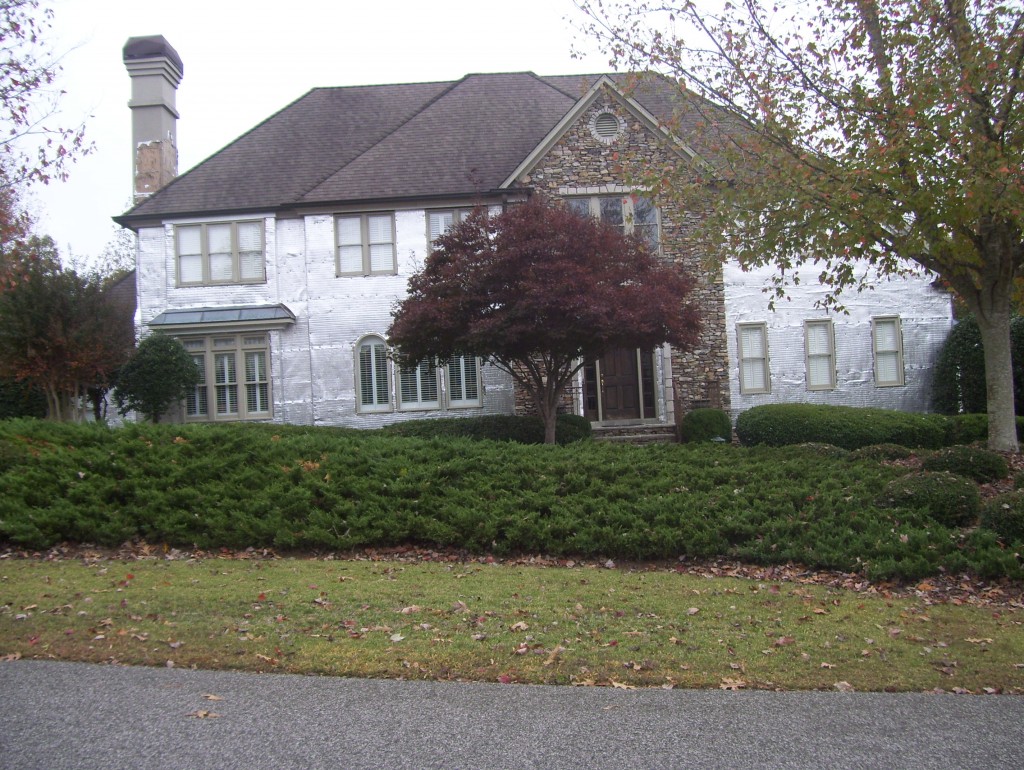 After looking at this house you may think that it was built with new fangled construction methods to help increase its energy efficiency and make it more “green”. But you would be wrong, as I was. When I passed it up I did a double take, but after driving by again I discovered that it is under going a siding replacement.
After looking at this house you may think that it was built with new fangled construction methods to help increase its energy efficiency and make it more “green”. But you would be wrong, as I was. When I passed it up I did a double take, but after driving by again I discovered that it is under going a siding replacement.
It was originally constructed of EIFS, which stands for Exterior Insulation and Finishing System, or simply put: synthetic stucco. This type of construction material has been used for years in commercial buildings with great success. Within the past 5-10 years it became popular in residential construction however, due to poor installation, moisture problems occurred, causing severe rotting and damage to the interior of the walls. The problem became so bad that homes with this type of construction suffered from a stigma attached to them which resulted in their sales prices being significantly less than other homes.
This home is having the EIFS removed and replaced with another type of siding. Have you had this problem in your market?
Amazing renovation. Would like to see photos of the completed job. Only saw a short photo of what was going to be done.
Thanks for reading.
Really it is a great article and more helpful to get the best assistance for Stucco and Plaster Repair. I am very glad to go through this kind of helpful blog. Thanks for sharing a nice article.
Thanks for reading.
We have had excellent results with EIFS, and continue to use it to this day, both commercially and residentially
Hi Tom, interesting that you bring this up. The moist, humid climate in Louisiana may not be that different than in AL. Yes, this was a problem in the past within Greater Baton Rouge market. The worst case I ever witnessed. I once went for a “refi” appraisal inspection on a home in a high end golf course development, Santa Maria, and found multiple locations of the exterior walls “gone”, evaporated. I couldn’t believe what I was witnessing. I walked into the home to find missing sections of drywall with black molded studs. I was then handed a report 1 inch thick containing the diagnosis and medical bills and reports on the medical issues this home had caused. Faulty installation was to blame, ie., not sealing the very bottom where the EIFS meets the home near the ground. If not sealed properly, the rain hits the ground and then bounces back up behind the EIFS. Over time, the moisture damage begins to compound.
However, it’s been many years since I’ve seen a problem with EIFS as the installation process has improved, even with the economy builders using this siding.
What I see more of now is vacant homes where the owners have to had to move out for the remediation of Chinese Drywall for homes built after 2005. One doctor had to move out of his home in University Club, rent another home in U. Club for like 6 months before his home was ready to move back into.
Appreciate You! Thank you for the heads up! Bill
Hey Bill, you are right about the faulty installation. As I said, I have not seen much about it lately except for this house I wrote about. I think they have gotten better about the construction and installation. Have there been enough cases of the Chinese Drywall where you can come up with some kind of adjustment? I have not had to appraise one yet but I know it would have to be a bear to do.
There is something to correct application now, isn’t there? I’ll have to look into this. Is this product more dominant in Southern states rather than West Coast?
Ryan, I have heard more about it in the southeast now that you mention it. Could possibly be because we have more moisture and humidity, but not sure.
Interesting article. I have not seen this problem in my market. In this homes market, will the owners see an increase in the value of their home or are they preserving the value by eliminating the stigma of the stucco.?
Bryan, the replacement of the siding will bring the value back in line to where it should be. Several years ago I saw differences of +- $50,000 between aa EIFS home and a brick home. This was for large custom built homes in the $300-$500,000 range. It has not gotten so much press lately due to other things happening in the market such as foreclosures and chinese drywall.
The Department of Energy has determined that EIFS are more energy efficient and control moisture better than brick, stucco, concrete block and fiber cement siding. In the past, there have been moisture-related issues with the system, but those problems only occurred when EIFS were not applied according to industry standards. With the proper application, the system works very efficiently.
Thanks for your comments. That is what I have found out also. Unfortunatley some of the builders did not learn the correct application methods and it really gave the product a bad name. Maybe with proper education this can change.